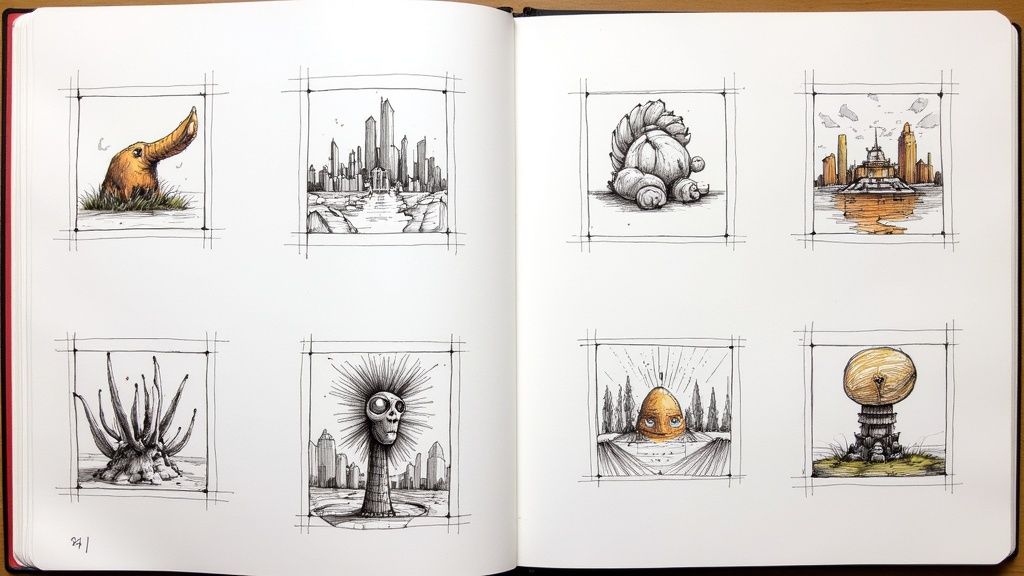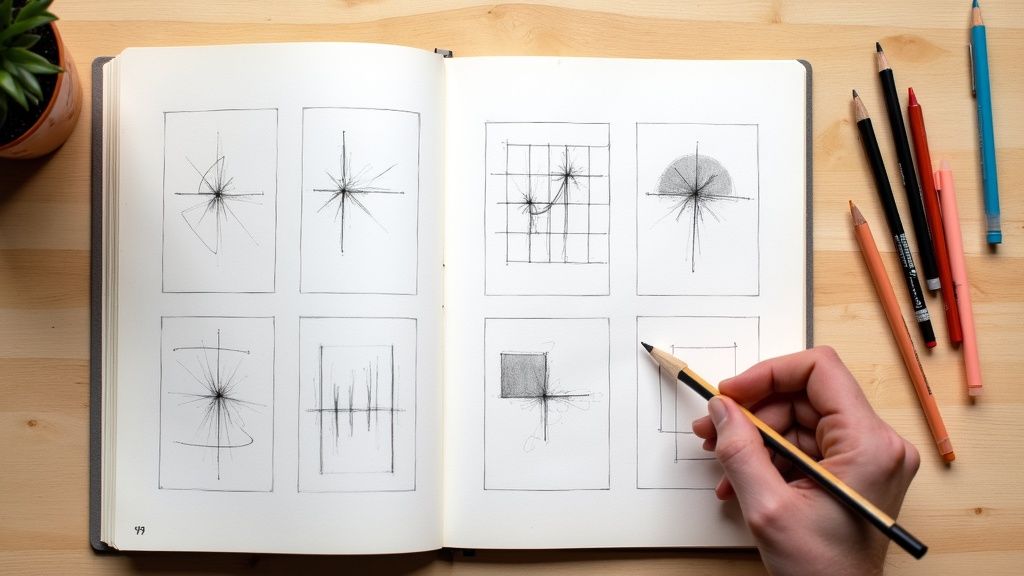Welcome, artists and creatives! Are you staring at a blank page, waiting for inspiration to strike? Whether you're a seasoned illustrator looking for a fresh challenge or a beginner eager to develop your style, finding the right spark can transform your art. This guide is packed with cute drawing ideas designed to break through creative blocks and fill your sketchbook with charming, whimsical, and delightful characters. We will move beyond generic suggestions to provide actionable starting points that help you build skills and have fun.
Our collection offers a diverse range of prompts, ensuring there's something to ignite every artist's imagination. You will learn how to approach different themes of cuteness, from the classic appeal of kawaii animals and chibi characters to the unexpected charm of everyday objects with expressive faces. We'll explore seven distinct categories, each offering a unique world of inspiration.
These prompts are more than just simple ideas; they are foundations for developing your personal aesthetic and technical abilities. Prepare to explore concepts like baby animals, food with faces, and mythical creatures, all through the lens of adorable art. Let's dive into a universe of cuteness and rediscover the pure joy of drawing.
1. Kawaii Animals
Kawaii, the Japanese culture of cuteness, offers a fantastic starting point for anyone looking for cute drawing ideas. This art style transforms ordinary animals into charming characters by emphasizing childlike features. The core principle involves simplifying forms and exaggerating proportions to evoke a sense of sweetness and innocence. The aesthetic is defined by oversized heads, large and expressive eyes, and tiny bodies, creating an instantly lovable figure.
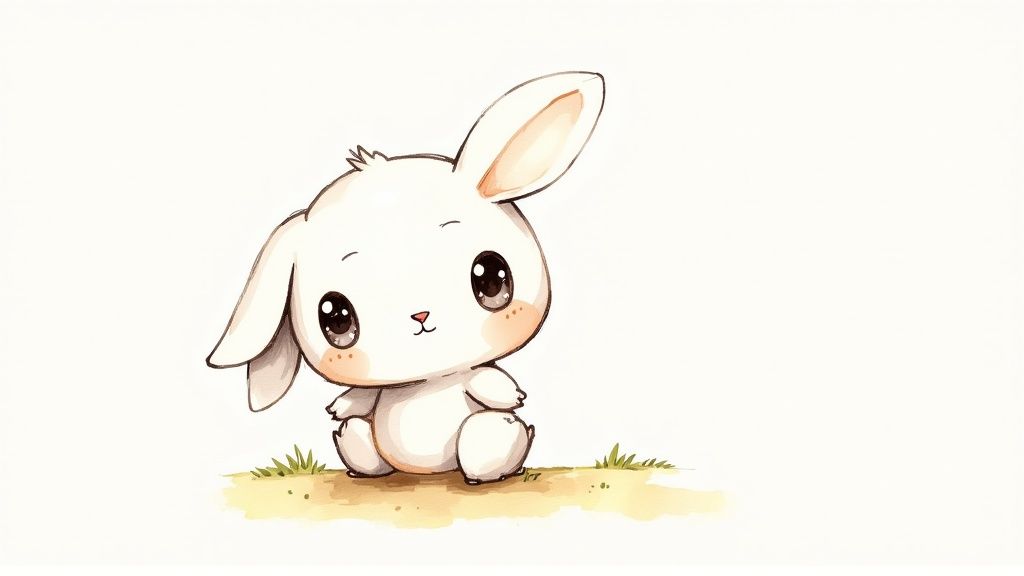
This style has been globally popularized by icons like Sanrio's Hello Kitty and the whimsical creatures from Studio Ghibli films, such as Totoro. Modern examples like Pusheen the Cat and the designs of many Pokémon demonstrate its enduring appeal. The goal is not anatomical accuracy but emotional connection; the simplified features make the characters more relatable and endearing.
How to Draw in a Kawaii Style
To start drawing your own kawaii animals, focus on a few key techniques that define the style. These simple rules are easy for beginners to follow and are foundational to achieving the desired effect.
- Start with Simple Shapes: Begin your drawing with basic geometric forms. A large circle for the head and a smaller oval for the body create the classic kawaii proportions instantly.
- Focus on the Eyes: The eyes are the most important feature. Make them large, round, and spaced far apart. An eye-to-head ratio of approximately 1:3 is a good guideline. Adding simple white highlights or "sparkles" will make them appear shiny and full of life.
- Simplify Facial Features: Keep the nose and mouth small and simple. A tiny dot or a small "w" shape for the mouth is often enough to convey expression without complicating the design.
- Add Personality: Give your character a unique touch with small accessories like a bow, a hat, or a tiny scarf. You can also place them in simple scenarios, like holding a piece of food or peeking out from behind an object.
This approach is perfect for creating stickers, character designs, or simply practicing a fun and forgiving art style. If you want to explore this style further, you can find a wealth of inspiration and more specific guides when you browse through various animal drawing ideas.
2. Chibi Characters
"Chibi" is a Japanese slang word for "small" or "short," and in the art world, it describes a specific style of caricature where characters are drawn in an exaggerated, super-deformed way. This style shrinks characters down, giving them large heads, small bodies, and simple, childlike features. The result is an irresistibly cute drawing idea that can make even the most serious characters look adorable and non-threatening. The goal is to capture the essence of a character while amplifying their charm.
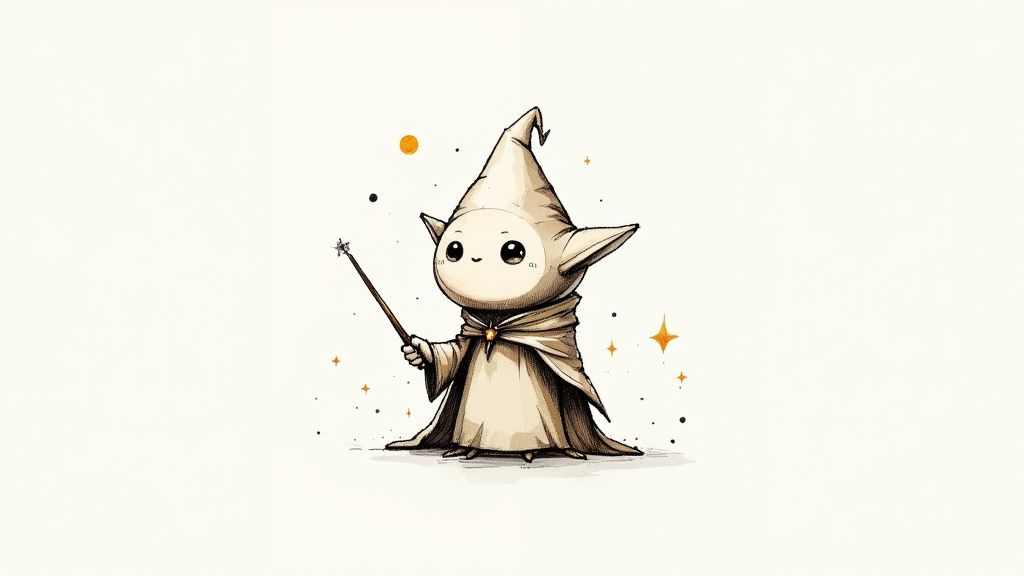
This art style is incredibly popular in anime and manga, often used for comedic scenes or special merchandise. Well-known examples include the chibi sequences in shows like Naruto and One Piece, the popular Nendoroid figure line by the Good Smile Company, and countless emotes used on platforms like Twitch and Discord. The appeal lies in its ability to simplify complex designs into something easily digestible and emotionally expressive, making it a favorite for fan art and character icons.
How to Draw Chibi Characters
Drawing in the chibi style is accessible even for beginners. By following a few key principles, you can transform any character into a cute, miniature version of themselves.
- Follow the 'Head-Tall' Rule: A classic chibi character is typically two to four heads tall. For maximum cuteness, the two-head-tall proportion is a great starting point, where the head and body are roughly the same size.
- Retain Key Features: Even though you are simplifying, make sure to keep the character's most recognizable traits. This includes their signature hairstyle, hair color, iconic outfits, or important accessories.
- Exaggerate Emotions: Chibi art thrives on clear, bold expressions. Focus on one single emotion, like joy, anger, or surprise, and exaggerate it with wide eyes, a large mouth, or dramatic blush marks.
- Simplify Hands and Feet: Don't worry about drawing detailed hands and feet. Simple mitten-like hands and rounded, shoe-like feet work perfectly for this style and maintain the overall cute aesthetic.
This approach is perfect for creating stickers, emotes, or simply reimagining your favorite characters in a fun, new way. If you are looking for more inspiration, you can find a variety of character drawing ideas to practice this and other styles.
3. Food with Faces
Adding faces to everyday food items is a classic and delightful way to generate cute drawing ideas. This style, known as anthropomorphism, transforms ordinary edibles into charming characters by giving them simple facial expressions, arms, and legs. It's an approach that taps into our ability to see human-like features in inanimate objects, creating instant personality and emotional connection with something as simple as a smiling donut or a grumpy piece of broccoli.
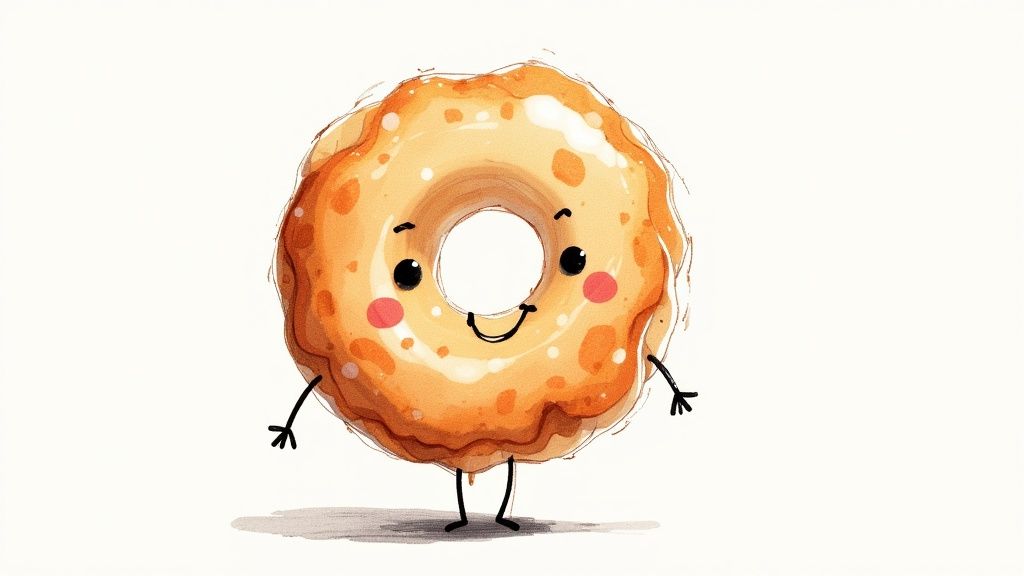
This whimsical style is everywhere, from the iconic mascots in advertising like the Pillsbury Doughboy to the intricate and adorable creations in Japanese bento box art. Contemporary illustrators like Lisa Congdon and countless food art accounts on social media have popularized this approach, demonstrating its broad appeal. The goal isn't just to draw food; it's to tell a small story or convey an emotion, making the mundane magical.
How to Draw Food with Faces
Creating your own cast of culinary characters is straightforward if you focus on a few key principles. These tips help you blend the food's natural form with expressive, human-like features.
- Study the Real Food First: Before you add a face, take a moment to observe the food's actual shape, texture, and color. A strawberry's bumpy surface or a croissant's flaky layers provide a realistic foundation for your character.
- Match Expressions to Food Traits: Think about the food's characteristics and match the expression accordingly. For example, a steaming loaf of bread might look sleepy and content, a zesty lemon could be energetic and happy, while a spicy chili pepper might have a mischievous or angry face.
- Keep Limbs Simple: Use simple lines or noodle-like shapes for arms and legs. This ensures the focus remains on the food item and its expressive face, preventing the character from becoming overly complex.
- Add Context and Interaction: Place your food characters in simple scenes to bring them to life. A happy avocado half could be waving to its other half, or a group of berries could be having a party in a fruit bowl. These small narratives add another layer of charm.
This technique is perfect for creating unique greeting cards, fun food-themed illustrations, or developing memorable characters. Its simplicity and universal appeal make it one of the most accessible and enjoyable cute drawing ideas for artists of any skill level.
4. Baby Animals
Drawing baby animals taps into our innate biological response to juvenile features, a concept known as the "baby schema" or Kindchenschema. This idea explains why we find features like large heads, big eyes, and small noses so endearing. By emphasizing these characteristics in your art, you can create illustrations that are not just visually appealing but also evoke a powerful emotional connection and a sense of warmth and protection.
This approach to creating cute drawing ideas has been mastered by storytellers and artists for generations. Classic Disney characters like Bambi and Simba and the gentle illustrations in Beatrix Potter’s books are perfect examples of using baby animal features to create lovable characters. Modern wildlife photographers and conservation campaigns also use these principles to foster a connection between humans and the natural world, highlighting the vulnerability and charm of young wildlife.
How to Draw Cute Baby Animals
Capturing the unique appeal of baby animals involves observing their distinct proportions and translating them into your art. These techniques will help you emphasize their natural cuteness.
- Study Proportions: Look at photos of real baby animals and compare them to their adult counterparts. Notice how their heads are disproportionately large for their bodies, their legs are often short and chubby, and their snouts are shorter.
- Focus on the Face: Make the eyes large, round, and set lower on the face to create a youthful look. Keep the nose and mouth small and delicate to maintain the "baby face" proportions.
- Use Soft Lines and Textures: Employ gentle, curved lines rather than sharp, angular ones. Use soft shading techniques to suggest fluffy fur or downy feathers, enhancing the sense of softness and vulnerability.
- Add Context: Place your baby animal in a natural setting to tell a story. Drawing them sleeping in a nest, playing with a sibling, or cautiously exploring their environment can make the scene more engaging and heartwarming.
This drawing style is ideal for creating emotionally resonant artwork, from children's book illustrations to heartfelt greeting cards. It allows artists to celebrate the beauty of the natural world in a way that is universally understood and appreciated.
5. Plants in Pots with Personalities
Bringing houseplants to life by giving them human-like personalities is a charming and relatable cute drawing idea. This concept involves illustrating plants with facial expressions, expressive body language, and placing them in amusing, everyday scenarios. The goal is to transform a simple potted plant into a character that reflects the joys and struggles of being a "plant parent," creating a humorous and endearing connection with the viewer.
This trend has flourished on social media, with artists and plant enthusiasts creating comics and illustrations that capture the quirky behaviors of different plant species. Think of a dramatic fiddle leaf fig wilting theatrically for attention, a cheerful sunflower beaming in the sun, or a sleepy succulent just waking up. These drawings give a voice to the silent members of our households, making them feel like part of the family.
How to Draw Plants with Personalities
To create your own botanical characters, blend accurate plant details with creative personification. This approach allows you to build a unique and engaging personality for each plant you draw.
- Match Personality to Plant Type: Research the specific care needs and characteristics of the plant you're drawing. A high-maintenance plant could be portrayed as needy or dramatic, while a resilient cactus might have a tough, independent personality.
- Use the Pot as Part of the Character: The pot is more than just a container; it's part of the plant's outfit. Use different pot styles, colors, and patterns to enhance the character's personality. A simple terracotta pot might suit a down-to-earth character, while an ornate one could belong to a fancier plant.
- Illustrate Relatable Scenarios: Draw your plant characters in situations that plant owners will recognize. This could include a plant looking thirsty, reacting to being repotted, or enjoying a sunbath on the windowsill. Showing different growth stages or seasonal changes also adds depth.
- Keep Expressions Simple but Effective: You don't need complex facial features. A pair of simple eyes and a small mouth can convey a wide range of emotions. Focus on how the leaves and stems can contribute to the body language, such as drooping for sadness or reaching upwards for happiness.
This concept is perfect for creating webcomics, stickers, or branding for a plant-related business. It offers endless opportunities for storytelling and is a wonderful way to combine a love for nature with character design.
6. Cute Mythical Creatures
Reimagining legendary beasts from folklore and mythology offers a treasure trove of cute drawing ideas. This approach takes majestic or even intimidating creatures like dragons, griffins, and hydras and filters them through a cute, approachable lens. The core idea is to blend the iconic features of these beings with charming, simplified aesthetics, turning them into friendly and adorable characters. The magic lies in the contrast between their powerful origins and their new, sweet appearance.
This style is prominent in many beloved franchises and artistic communities. Modern examples range from the unicorn variations of Pusheen to the vibrant cast of My Little Pony, redesigned by Lauren Faust. The world of Pokémon is built on this concept, and countless independent artists on platforms like Etsy have found success creating stickers, prints, and plushies of chibi-style fantasy creatures. The goal is to make the mythical accessible and lovable, creating a character that feels both fantastical and personal.
How to Draw Cute Mythical Creatures
To transform a classic mythical beast into a cute character, focus on softening its features while retaining the key elements that make it recognizable. These techniques help you capture their essence in an endearing way.
- Research and Simplify: Start by researching the lore of your chosen creature, like a kirin or a manticore. Identify its most important features- a unicorn's horn, a dragon's wings, or a phoenix's fiery tail- and make those the focal point while simplifying the rest of the anatomy.
- Emphasize Softer Shapes: Use round, soft shapes for the body, head, and limbs, similar to the kawaii style. Avoid sharp angles and menacing details like overly long claws or teeth. Instead, make them small and stubby to add to the charm.
- Add Magical Elements: Use visual cues like sparkles, glows, and soft, pastel color palettes to emphasize the creature's magical nature. A soft glow around a unicorn’s horn or a trail of glitter from a fairy's wings instantly enhances the whimsical feel.
- Give Them a Backstory: Creating a simple personality or backstory can bring your character to life. Is your baby griffin mischievous? Is your tiny kraken shy? This narrative depth makes the drawing more engaging and can inspire a whole series of illustrations.
This approach is perfect for developing unique original characters (OCs), creating fantasy-themed merchandise, or simply adding a touch of magic to your sketchbook. It allows for immense creativity by blending established folklore with your personal artistic style.
7. Everyday Objects with Emotions
Transforming mundane items into lively characters is one of the most imaginative cute drawing ideas. This approach involves anthropomorphism, where you give everyday objects human-like qualities such as faces, limbs, and emotions. The charm comes from creating a hidden world where inanimate things have their own personalities, relationships, and stories, turning a simple coffee mug or a forgotten sock into the protagonist of a mini-drama. The goal is to find the story potential in the ordinary and bring it to life.
This concept has been a staple in animation and storytelling for decades, seen in classics like Disney's Beauty and the Beast with its enchanted household staff or the adventurous appliances in The Brave Little Toaster. Modern webcomic artists and advertisers frequently use this style to create relatable and memorable content, from a grumpy alarm clock dreading Monday to a joyful pair of rain boots splashing in puddles. This technique makes the objects more engaging and forges an emotional connection with the viewer.
How to Draw Everyday Objects with Emotions
Giving life to inanimate objects is a fun exercise in creativity. By focusing on expression and context, you can turn any simple item into a compelling character.
- Choose an Expressive Object: Start with items that have interesting shapes or clear functions. A wilted plant can look sad, a sharp knife can appear mischievous, and a puffy marshmallow can seem soft and friendly.
- Match Emotions to Function: Use the object's purpose to inspire its personality. An eraser could be constantly stressed and shrinking from its mistakes, while a brand-new sketchbook could be wide-eyed with excitement and possibility.
- Create Relationships and Stories: Don't just draw one object; draw two or more interacting. A salt and pepper shaker in love, a family of lightbulbs, or rival cleaning supplies can create a dynamic scene.
- Use Simple Faces: You don't need complex features. Two dots for eyes and a simple line for a mouth are often enough to convey a wide range of emotions. Placement is key; placing features low on the object can make it appear cuter.
This style is excellent for developing storytelling skills and is a fantastic source of endless creative prompts. It's a particularly accessible and rewarding exercise, making it one of the best drawing ideas for beginners who want to practice expression and character design.
Cute Drawing Ideas Comparison Chart
Style | Implementation Complexity | Resource Requirements | Expected Outcomes | Ideal Use Cases | Key Advantages |
|---|---|---|---|---|---|
Kawaii Animals | Low to moderate | Basic drawing tools and colors | Cute, universally appealing characters | Merchandise, social media, beginner art | Easy shapes, forgiving style, highly marketable |
Chibi Characters | Moderate | Basic to intermediate sketches | Super-deformed, expressive, adorable | Stickers, digital art, emoticons | Expressive emotions, quick to draw, broad appeal |
Food with Faces | Low | Simple drawing tools | Relatable, charming anthropomorphic food | Food blogs, marketing, social media | Unlimited subjects, emotional narratives, easy |
Baby Animals | Moderate to high | Reference photos, anatomy knowledge | Emotional, nurturing, realistic juveniles | Wildlife art, children’s books, social campaigns | Scientifically proven appeal, storytelling |
Plants in Pots with Personalities | Moderate | Botanical knowledge helpful | Relatable, humorous plant characters | Plant communities, branding, education | Highly relatable, educational, endless variety |
Cute Mythical Creatures | Moderate | Imagination, myth research | Adorable fantasy characters | Children’s content, merchandising | Combines fantasy and kawaii, high creativity |
Everyday Objects with Emotions | Low | Minimal tools | Engaging, relatable narratives with objects | Comics, minimalist art, storytelling | Easy subject matter, highly relatable, versatile |
Keep Your Creativity Flowing with Endless Ideas
We have explored a vibrant landscape of creativity, journeying through seven distinct and delightful categories of cute drawing ideas. From the simple charm of kawaii animals and food with faces to the expressive personalities of chibi characters and potted plants, you now have a powerful toolkit to combat creative blocks and keep your sketchbook full. The journey doesn’t end here; it’s a continuous cycle of practice, exploration, and discovery.
The true value in mastering these concepts lies not just in creating a single adorable illustration, but in building a versatile artistic skill set. By practicing how to add expressive eyes to an inanimate object or simplifying a complex animal into its most endearing chibi form, you are training your brain to see the world through a creative lens. This ability to inject personality and charm into any subject is an invaluable asset for any artist, whether you are a hobbyist looking for a relaxing pastime or an aspiring professional building a portfolio. These exercises are the building blocks of a stronger artistic foundation.
Turning Inspiration into Action
To make the most of this newfound inspiration, it’s crucial to establish a consistent drawing habit. Don’t wait for the perfect moment or the perfect idea to strike. Instead, make a conscious decision to create, even if it’s just for a few minutes each day.
Here are some actionable next steps to keep your artistic momentum going:
- The Mix-and-Match Challenge: Don’t feel confined to a single category. Challenge yourself by combining two or more ideas from the list. Try drawing a cute mythical creature in a chibi style, or perhaps a family of baby animals disguised as everyday objects. This cross-pollination of concepts is a fantastic way to generate unique and unexpected cute drawing ideas.
- Develop a Character: Choose one of your favorite drawings from these prompts, perhaps a brave little mushroom or a shy dragon. Give it a name and a simple backstory. Then, draw it in different poses, expressing various emotions, and interacting with other characters. This turns a simple prompt into a long-term project.
- Build a Thematic Collection: Dedicate a week or a month to exploring a single category in depth. For example, spend a week drawing nothing but food with faces, experimenting with different types of cuisine and expressions. This focused practice can lead to rapid improvement and a cohesive series of artwork.
Ultimately, the goal is to transform these prompts from a simple list into a launchpad for your own unique artistic voice. Use them as a starting point, but always be ready to add your personal twist. The world is filled with potential subjects just waiting for you to add a touch of cuteness. By consistently applying these techniques, you will find that inspiration isn't something you wait for; it's something you create. Grab your pencil, open your sketchbook, and let the adorable adventures begin.
Ready for a never-ending stream of inspiration? When you need a fresh prompt on demand, the Drawing List idea generator is your ultimate creative partner. With thousands of unique ideas, including an entire category dedicated to cute drawing ideas, you’ll never face a blank page again. Explore endless possibilities at Drawing List today!
